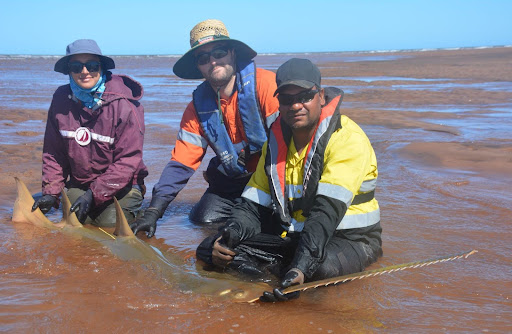Take a shark, flatten it out with a rolling pin and slap a hedge trimmer blade on its nose. You’ve got yourself a green sawfish.
The serrated, saw-like nose – known as a rostrum – is the defining feature of the critically endangered species Pristis zijsron that calls the estuaries along the northwestern coast of Western Australia home.
The rostrum is composed of electro-sensing cells that help the green sawfish navigate through estuaries and tropical waters and detect prey. Coming upon a school of fish, a green sawfish (which, to be clear, is a ray, not a shark) will swing it side to side and stun its meal. But human activity has turned the rostrum from tool to trouble.
“Sawfish are incredibly susceptible to becoming entangled in fishing nets,” says Jack Ingelbrecht, a research fellow with Murdoch University’s Harry Butler Institute. The rostrum is typically composed of two dozen or so teeth, jutting out on either side. If the saw becomes ensnared in a fishing gill net, sawfish can’t free themselves. You can end up with a sore sawfish – or worse.
Jack has been studying the breeding behaviours of green sawfish in the Ashburton River and its adjacent tidal creeks. About 12 years ago, researchers discovered the region was a green sawfish nursery where juveniles are born every spring. The sawfish use the cover of the mangroves for protection and the estuarine waters are rich with food.
“It’s proven to be one of the most important discoveries for green swordfish research, not only in the region but also in Australia, because it just provides a reliable, robust population that you can sample across multiple years,” he says.
To date, sawfish reproduction has been one of the species’ closely guarded secrets. There’s not a lot of evidence for breeding and relationship behaviours, which makes it difficult to assess populations and plan conservation activities.
In new research, Jack and other researchers took samples from the pectoral and pelvic fins of more than 100 green sawfish in the Ashburton River and creeks between 2011 and 2022. The aim was to determine kinship – how the sawfish in the area are related.
Studying the DNA of the green sawfish from the fin samples was the first step. Genetics dictates that parents and offspring will share 50% of their DNA but so do siblings – complicating things if you’re trying to find out who is related to whom.
Jack says they compared DNA analyses with catch data: when and where individuals had been caught. This was the key to determining relationships and building out a family tree for the Ashburton River populations.
The analyses also helped to definitively show both female and male sawfish are philopatric, which means they remain in or return to sites that are of biological importance. The study showed that females tend to return to the river sites to give birth or pup – meaning it acts as both a maternity ward and a home for sawfish families.
“The advantage is that, by reusing a proven site that has supported your offspring in the past, it can increase the chances of offspring essentially surviving until maturity,” Jack says.
For males, philopatry has a slightly different purpose. It appears males return to a site where they are more likely to mate with females – but this was inferred from the DNA analyses rather than direct observations. In fact, wild mating has never been seen, not even by Jack, who has spent many hours in the waterways over the last 4 years sampling the rays.
The research work was supported by the Chevron Australia Sea Rangers, which provided Jack’s team with knowledge from Traditional Owners of the region, the Thalanyji people.
“A lot of our research may not have been possible without the collaboration of First Nations people, whether it be collecting tissue biopsies for genetics projects, tagging sawfish for tracking or even conducting drone surveys to get a better idea of the marine fauna in the area,” says Jack.
Chevron Australia has a major gas operation in Ashburton North and is developing offshore drilling sites. Alongside pesky gill nets from fishing activities that may unwittingly snare a sawfish by the rostrum, further development in the area could hinder sawfish populations. Monitoring the degradation of the habitat will be important for strengthening the already critically endangered green sawfish populations.
“This study really emphasises the importance of protecting these critical sites that are just so important for sawfish families,” he says.










